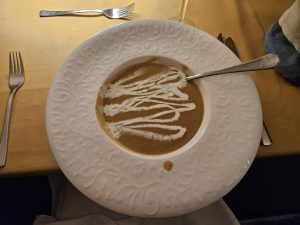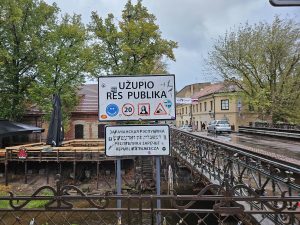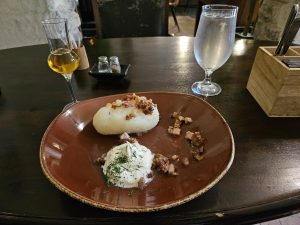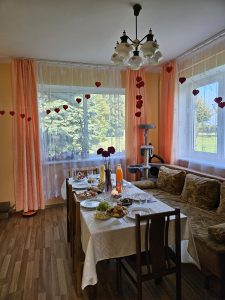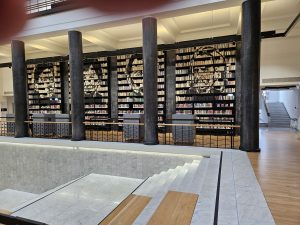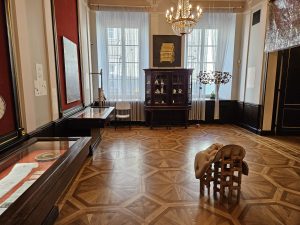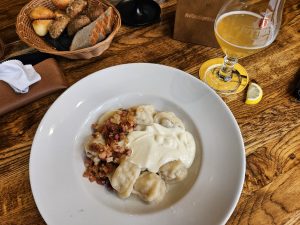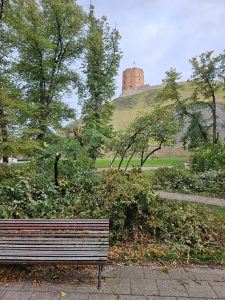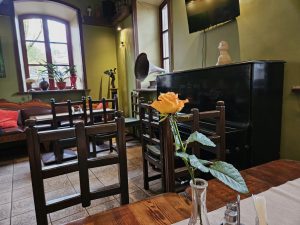Vilnius—in fact, all of Lithuania—is a constant experience of déjà vu. Or perhaps more accurately, jau matytas. Every day seemed a trip down Memory Lane.
October 6
I hadn’t planned to be ensconced in my room at Bookinn B&B by that day, but I had fled the pas Radvila in Kaišiadorys. By six or seven I was more than peckish. I consulted Google Maps for a suggestion and settled on Lokys, around the corner on Stiklių gatvė. The website said it specialized in Lithuanian food and occupied a medieval building. I was hoping for grybų sriuba, mushroom soup, full of boletus. Dan and I had eaten mushroom soup our first night in Užupis. This was a different kind of soup, full of cream and herbs, but every bit as delicious.
October 7
I walked to Užupis through a light rain, to find that really excellent French bakery where I had bought our morning treats. It was still there and I also bought a couple of madeleines to enjoy later.
I took the Angel Passage, as we had so many times, down the hillside. It leads to the Vilnia via Vilnius Academy of Arts and the passage has been gentrified into a glossy gallery district. Changes. Gentrification.
A pub on Stiklių—Alinė Leičiaia—advertised not just traditional food but local beers and wines. My čepellinai, little potato zeppelins, put shame to the ones we had at the truck stop near the Nemunas Tour in Kaunas in 2012—and those were pretty good. That little glass of golden mead warmed me through.
October 8
A day spent with the Tamkai is a blast from the past: Audrius, Diana, Salvija and Orestas plus Domantas Šilkaitius, Salvija‘s husband, and a couple of cats. Audrius said grace over a table groaning with food and then gave us a moment of silence to remember Dan. Sigh.
I think last time we enjoyed shots of 999. This time a more gentle mead.
It‘s a good thing we planned this gathering. Thanks to my tardiness, I discovered I was still running on Paris time. Had been for five days at that point. I thought it was a bit after ten; it was in fact after eleven.
Imagine what might have been the case if I were running an hour late on October 12 when I needed to catch a flight to London.
October 9
Monday was library day. A certain Juozapas Tomkus, likely a cousin of Dan‘s, wrote the definitive book on their home village: Meižonys. Having discovered the book online, I couldn‘t beg or buy a copy.
Audrius, however, went to the National Library of Lithuania, pulled their copy and started scanning and he sent the scans via Dropbox. He read as he scanned and his notes were invaluable.
About seven hours later I had determined two things. The first is that Dan‘s family can be traced well into the 18th century, pretty amazing for people who were illiterate peasants. The second is that Tomkus‘ interests in genealogy extended only to family members who remained tied to land in the village. That included his antecedents, of course. It also excluded immigrants.
There was nary a mention of the brothers Kazimir, Petras and Juozas Tomkus aka Tamkus who sought their fortunes in the coal mines of Scranton, Pennsylvania. Nor was there any note about the tragic deaths of Kazimir and Petras in the Diamond Mine Disaster in December 1914.
I am sure other village residents immigrated; neither Audrius nor I could determine who they were. An incomplete history to be sure.
October 10
The Vilnius Picture Gallery advertised a couple shows that caught my eye. The new curators—and there obviously are new curators—are brilliant. Dan and I were there in 2015 and it was a different place altogether.
A contemporary artist had created a Kunstkammer, a “chamber of curiosities” that was a modern version of the way a gentleman in the 16th or 17th centuries might have displayed his collections of art and oddments. It was a hoot.
The self-portraits dated to the 19th century to the present. They were not only wonderful works of art but beautiful interpreted in Lithuanian and English.
And the Florinem exhibition!
It started with a botany as a science and the Lithuanian position in the forefront of that discipline in the 16th and 17th century. There were books, drawings, specimens, sculptures. Everything. From there the show dove deep into the importance of flowers throughout art history. It explored religious iconography, discussed the picturesque gardening movement and the social life of women through paintings and drawings, items of furniture, religious vestments and sculptures.
Quite overwhelmed and extremely hungry, I stopped in at Amantininkų Užeiga. The restaurant is a jolly place, well positioned on Rotušės Alėjoje, a main drag, for the tourist trade. The server in that toasty-warm dining room gave me the English-language menu; I ordered a Svyturus Baltijos beer while perusing the offerings.
Koldunai! “Lithuanian ravioli.” My server seemed surprised that I knew the word. This serving wasn’t up to the standards we had enjoyed at Koldunai (the restaurant) in 2012. In fact, it wasn’t as good as Dan and I made. But it was the right meal at the right time.
October 11
I had thoughts of walking up to Gediminas‘ Tower but the gates were still locked at a few minutes before ten. And it was cold and gray, and I was distracted by workmen chainsawing the trees fallen in the storms of recent days.
On to the National Museum then. We had visited with Audrius Tamkus and family in 2015. The ticket seller suggested a ticket for “Tour II.” A guard sorted me out in the galleries. The building is extremely confusing and at that moment nearly devoid of visitors. A couple of period rooms have been reconfigured as picture galleries, showcasing some good European paintings from the 16th to the 18th centuries. Nice change of pace.
I knew where to go for lunch: Užupio Kavinė. Back to my beloved Užupis. I ended the visit almost where it began and said another thanks in the last place Dan and I had been together. Then a wander around Old Town, up to the Gates of Dawn and back down.
A very sentimental journey.

